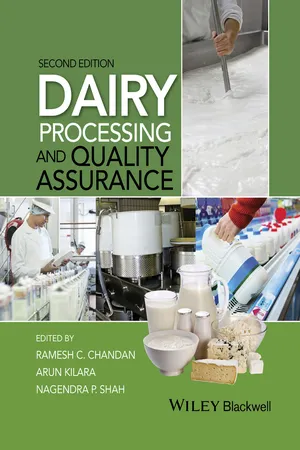
- English
- ePUB (mobile friendly)
- Available on iOS & Android
Dairy Processing and Quality Assurance
About this book
Dairy Processing and Quality Assurance, Second Edition describes the processing and manufacturing stages of market milk and major dairy products, from the receipt of raw materials to the packaging of the products, including the quality assurance aspects.
The book begins with an overview of the dairy industry, dairy production and consumption trends. Next are discussions related to chemical, physical and functional properties of milk; microbiological considerations involved in milk processing; regulatory compliance; transportation to processing plants; and the ingredients used in manufacture of dairy products. The main section of the book is dedicated to processing and production of fluid milk products; cultured milk including yogurt; butter and spreads; cheese; evaporated and condensed milk; dry milks; whey and whey products; ice cream and frozen desserts; chilled dairy desserts; nutrition and health; sensory evaluation; new product development strategies; packaging systems; non-thermal preservation technologies; safety and quality management systems; and dairy laboratory analytical techniques.
This fully revised and updated edition highlights the developments which have taken place in the dairy industry since 2008. The book notably includes:
- New regulatory developments
- The latest market trends
- New processing developments, particularly with regard to yogurt and cheese products
- Functional aspects of probiotics, prebiotics and synbiotics
- A new chapter on the sensory evaluation of dairy products
Intended for professionals in the dairy industry, Dairy Processing and Quality Assurance, Second Edition, will also appeal to researchers, educators and students of dairy science for its contemporary information and experience-based applications.
Frequently asked questions
- Essential is ideal for learners and professionals who enjoy exploring a wide range of subjects. Access the Essential Library with 800,000+ trusted titles and best-sellers across business, personal growth, and the humanities. Includes unlimited reading time and Standard Read Aloud voice.
- Complete: Perfect for advanced learners and researchers needing full, unrestricted access. Unlock 1.4M+ books across hundreds of subjects, including academic and specialized titles. The Complete Plan also includes advanced features like Premium Read Aloud and Research Assistant.
Please note we cannot support devices running on iOS 13 and Android 7 or earlier. Learn more about using the app.
Information
1
Dairy Processing and Quality Assurance: An Overview
Introduction
Table of contents
- Cover
- Title Page
- Copyright
- Contributors
- Preface to the Second Edition
- Preface to the First Edition
- Chapter 1: Dairy Processing and Quality Assurance: An Overview
- Chapter 2: Dairy Industry: Production and Consumption Trends
- Chapter 3: Mammary Gland and Milk Biosynthesis: Nature's Virtual Bioprocessing Factory
- Chapter 4: Chemical Composition, Physical, and Functional Properties of Milk and Milk Ingredients
- Chapter 5: Microbiological Considerations Related to Dairy Processing
- Chapter 6: Regulations for Product Standards and Labeling
- Chapter 7: Milk from Farm to Plant
- Chapter 8: Dairy-Based Ingredients
- Chapter 9: Fluid Milk Products
- Chapter 10: Cultured Milk and Yogurt
- Chapter 11: Butter and Fat Spreads: Manufacture and Quality Assurance
- Chapter 12: Cheese
- Chapter 13: Evaporated and Sweetened Condensed Milks
- Chapter 14: Dry Milk Products
- Chapter 15: Whey and Whey Products
- Chapter 16: Ice Cream and Frozen Desserts
- Chapter 17: Puddings and Dairy-Based Desserts
- Chapter 18: Role of Milk and Dairy Foods in Nutrition and Health
- Chapter 19: Sensory Evaluation of Milk and Milk Products
- Chapter 20: Product Development Strategies
- Chapter 21: Packaging Milk and Milk Products
- Chapter 22: Potential Applications of Nonthermal Processing Technologies in the Dairy Industry
- Chapter 23: Management Systems for Safety and Quality
- Chapter 24: Laboratory Analysis of Milk and Dairy Products
- Index
- End User License Agreement